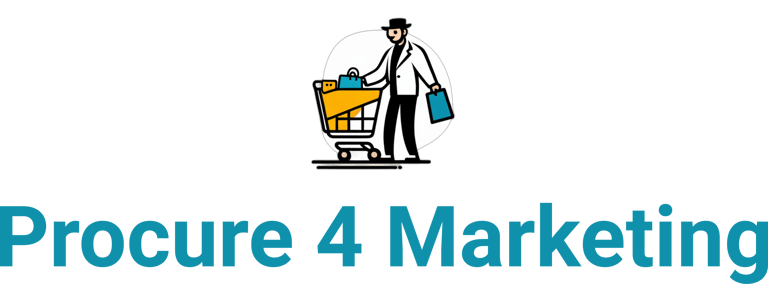What Are the Key Differences Between Advertising and Marketing Procurement?
What's the difference between Marketing Procurement and Advertising Procurement? This guide provides a clear, side-by-side comparison of scope, strategy, metrics, and more.
MARKETING PROCUREMENT
The Procure 4 Marketing Team
10/19/20233 min read


Quick Answer: What is the difference?
The main difference between Marketing Procurement and Advertising Procurement is scope. Advertising Procurement is a specialized subset focused narrowly on buying advertising space and creative services (the "Promotion" part of the 4 Ps). Marketing Procurement is much broader, covering the strategic sourcing of all marketing activities, including market research, branding, PR, technology, and events. Advertising is just one of the many categories that Marketing Procurement manages.
What is Marketing Procurement vs. Advertising Procurement?
While often confused, these two functions have distinct roles.
· Advertising Procurement focuses on the tactical execution of getting ads to market. Its job is to efficiently buy the media space and creative services needed for a specific campaign.
· Marketing Procurement takes a holistic, strategic view. Its job is to manage the commercial relationships for the entire marketing ecosystem, ensuring all parts work together to achieve long-term business goals.
A Simple Analogy: Building a House
Think of building a house:
· Advertising Procurement is like hiring the best electrician to wire the house and a great painter to paint the walls. It's a specialized, execution-focused task.
· Marketing Procurement is like being the general contractor for the entire project. They hire the architect, the foundation crew, the plumbers, the electricians, and the painters, ensuring they all work together to build a high-quality house on time and on budget.
The Key Differences: A Side-by-Side Comparison
Here are the six key areas where these two functions differ.
1. Scope
· Advertising Procurement (Narrow): Focuses specifically on sourcing the inputs for promotional campaigns. This includes media buying (TV spots, digital ads) and selecting creative/production agencies.
· Marketing Procurement (Broad): Covers the entire marketing landscape. This includes everything in advertising, plus market research firms, PR agencies, branding consultants, event management companies, and marketing technology (MarTech) software.
2. Strategic Intent
· Advertising Procurement (Short-Term & Tactical): The primary goal is to ensure the successful and cost-effective execution of a specific ad campaign to drive immediate visibility and engagement.
· Marketing Procurement (Long-Term & Strategic): The goal is to build a high-performing roster of agency partners and a technology stack that supports the company's long-term brand-building and market share goals.
3. Stakeholders
· Advertising Procurement Stakeholders: Works directly with a focused group of partners like media buying agencies, TV networks, production houses, and creative agencies.
· Marketing Procurement Stakeholders: Manages a much wider and more diverse network of partners, including market research firms, SEO specialists, event venues, PR agencies, and software providers.
4. Metrics of Success
· Advertising Procurement Metrics: Success is measured with campaign-specific KPIs.
o Examples: Click-Through Rate (CTR), Cost Per Acquisition (CPA), Reach, and Impressions.
· Marketing Procurement Metrics: Success is measured with broader, long-term business metrics.
o Examples: Return on Marketing Investment (ROMI), Brand Equity, Customer Lifetime Value (CLV), and Market Share Growth.
5. Budget Considerations
· Advertising Procurement Budget: Manages the budget allocated specifically for media buys and ad production for a campaign.
· Marketing Procurement Budget: Oversees the entire marketing budget, which is a diverse portfolio of investments across research, technology, events, PR, and advertising.
6. Risk Factors
· Advertising Procurement Risks: Focuses on mitigating campaign-level risks.
o Examples: An ad being placed in an unsafe environment (brand safety), a creative campaign failing to resonate, or overspending on media buys.
· Marketing Procurement Risks: Manages broader strategic risks.
o Examples: Investing in the wrong market research data, which leads to a flawed strategy; selecting a PR agency that mishandles a crisis; or non-compliance with data privacy laws like GDPR.
Frequently Asked Questions (FAQ)
Q1: Which one is more important, Marketing or Advertising Procurement?
They are both important and work together. Advertising Procurement is a critical specialty within the broader function of Marketing Procurement. You can't have effective Marketing Procurement without expertise in its largest component, which is often advertising.
Q2: In a small company, are these roles combined?
Yes. In most small to medium-sized businesses, there isn't a distinction. A single Marketing Procurement manager, or even a general Procurement Manager, will handle both the broad marketing strategy and the specific advertising buys. The roles become more specialized as the company and its marketing budget grow.
Q3: Does one report to the other?
Typically, an Advertising Procurement specialist or manager would report to a Director or Head of Marketing Procurement, who in turn reports to the Chief Procurement Officer (CPO).

